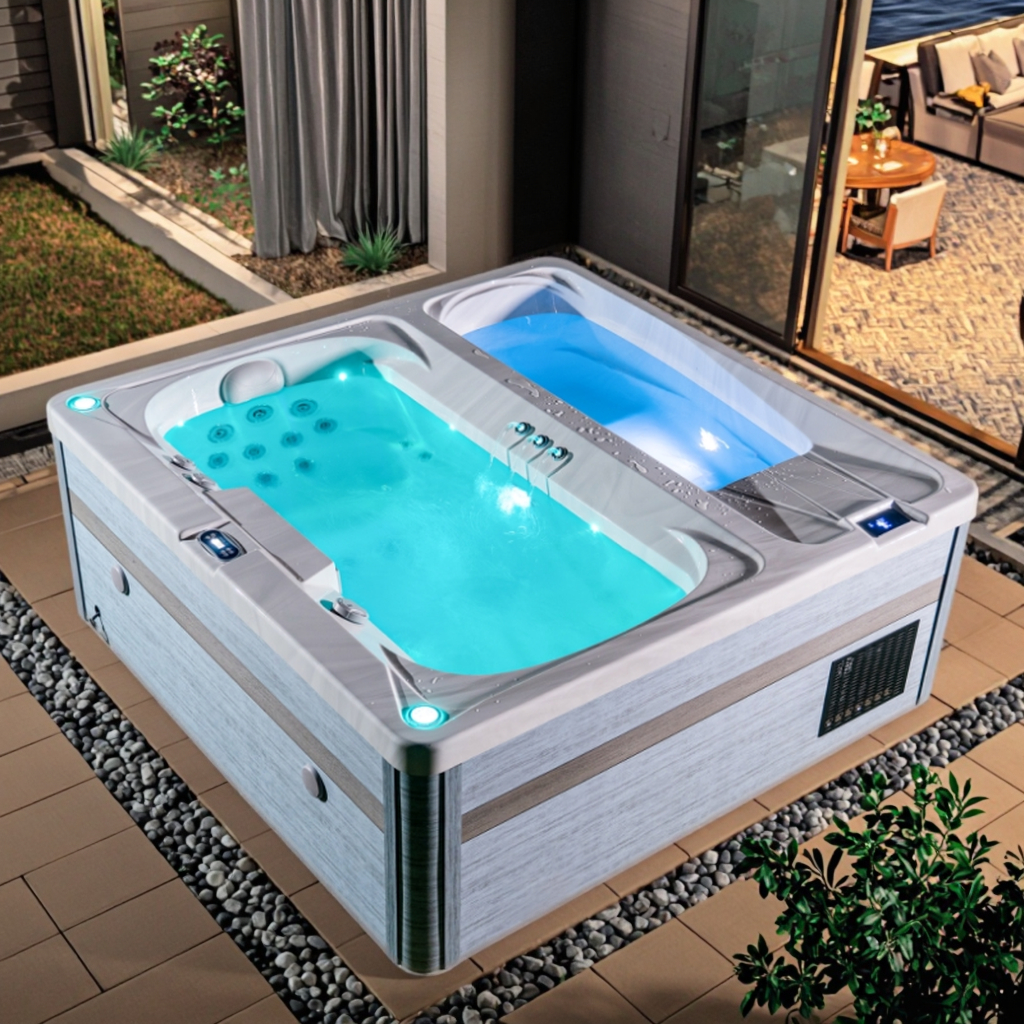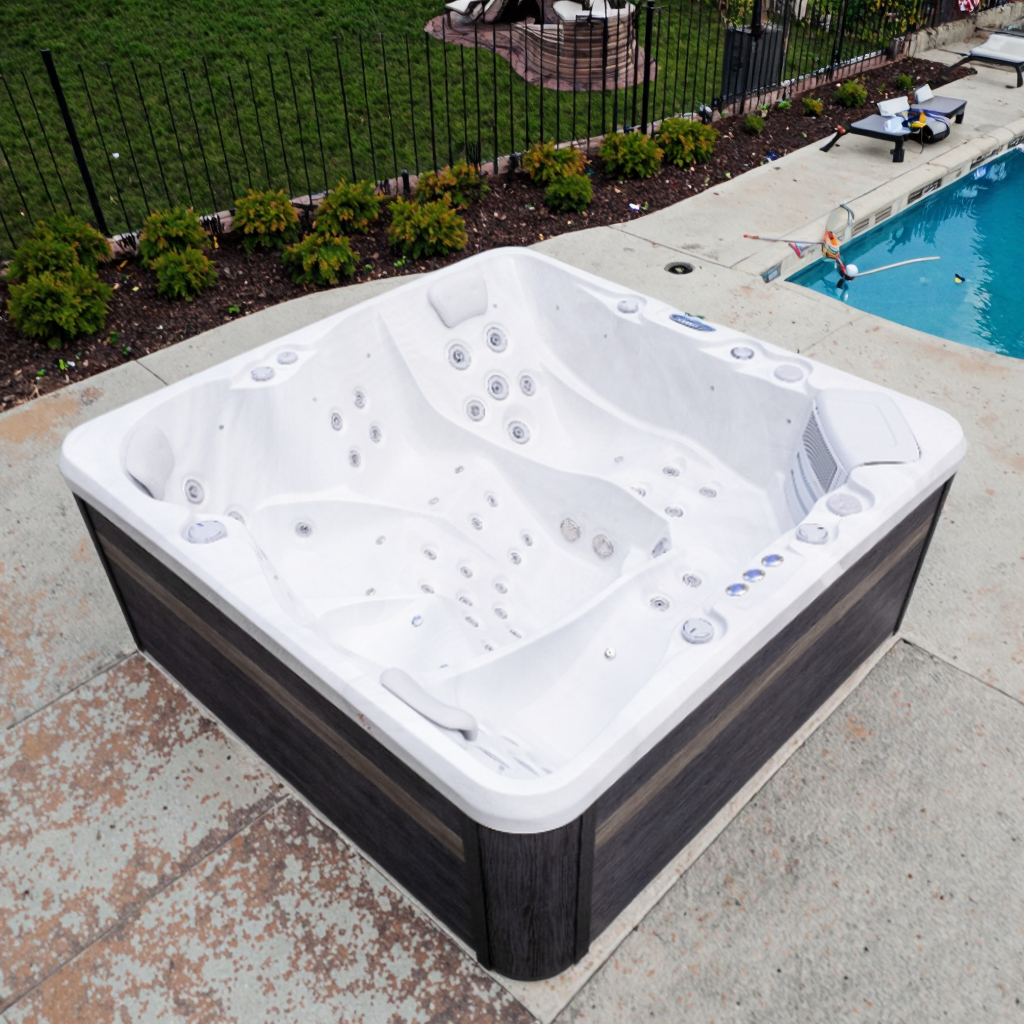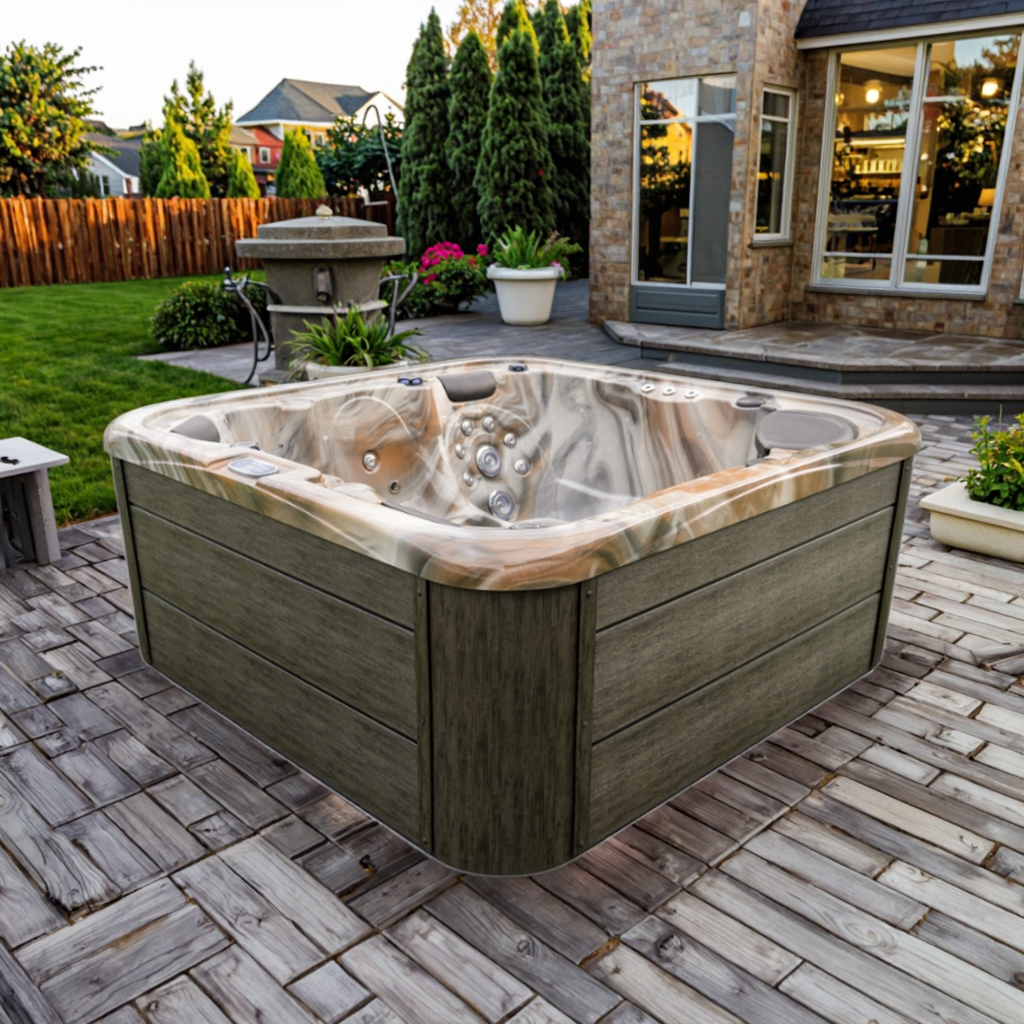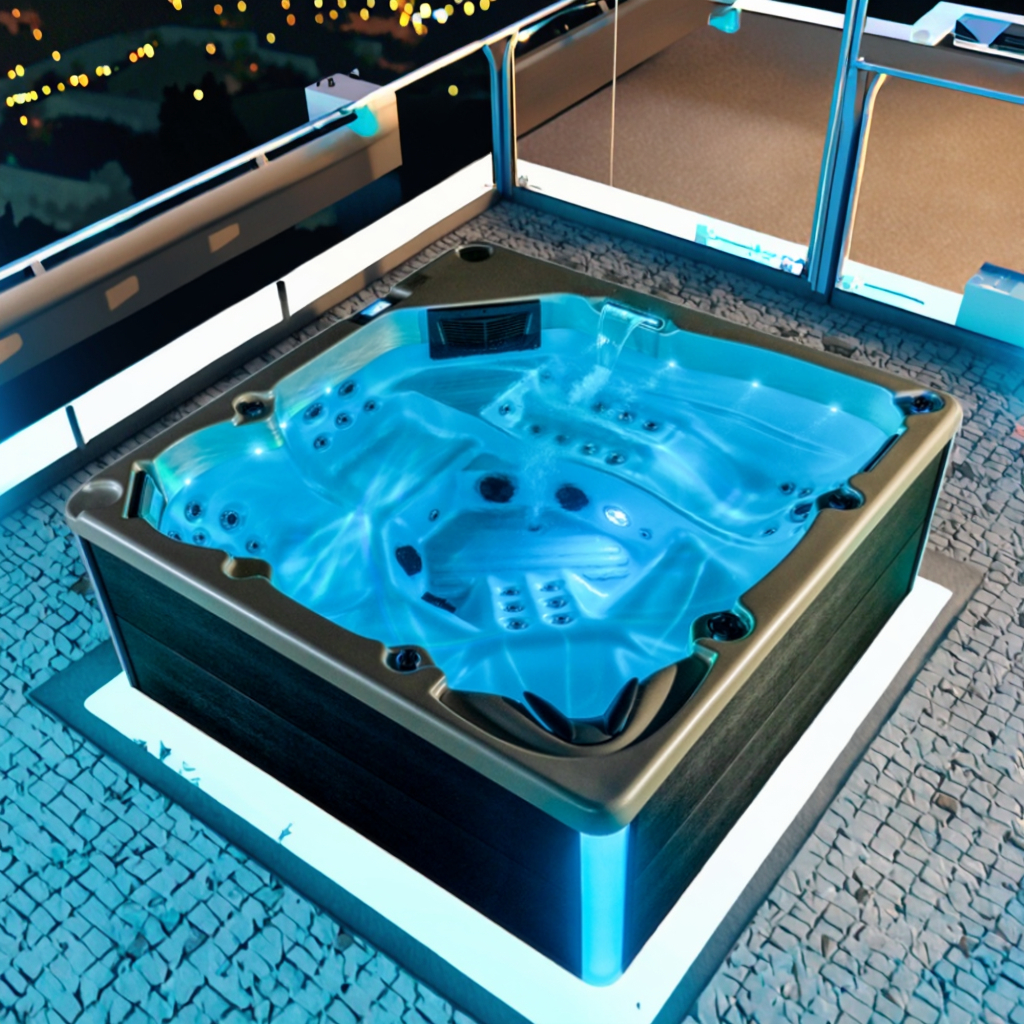
What is the optimal thickness for an acrylic spa tub?
2025-10-28 15:35Acrylic spa tubs, with their excellent thermal insulation, delicate texture, lightweight, flexible fabrication, and diverse design options, have secured a firm foothold in modern bathroom design and leisure and wellness spaces. When purchasing or customizing an acrylic spa tub, consumers often face a key technical question: what is the optimal thickness?
Thickness not only determines the structural strength and load-bearing capacity of an acrylic spa tub but also directly impacts its insulation, durability, maintenance frequency, and even user comfort. Therefore, an in-depth discussion of this issue will help users make informed decisions when selecting or evaluating a product.
This article will systematically examine the optimal thickness range for acrylic spa tubs, taking into account the physical properties of acrylic, the manufacturing process, load-bearing requirements, thermal cycle characteristics, support structure compatibility, and long-term stability. It will also provide a clear and professional evaluation guide for the application scenarios and technical pros and cons of different thicknesses.

Material Properties of Acrylic Spa Tubs
Before discussing thickness, we must first understand the basic physical properties of acrylic. Acrylic, known scientifically as polymethyl methacrylate (PMMA), is a transparent thermoplastic with the following key properties:
· Density: 1.18 g/cm³, making it lightweight and easy to handle and install;
· Elastic modulus: approximately 3.2 GPa, providing a certain degree of flexibility;
· Vicat softening point: approximately 105°C, capable of withstanding high temperatures typical of household water use;
· Coefficient of thermal expansion: High, requiring appropriate support design;
· Impact resistance: 8-10 times that of ordinary glass;
· High resistance to UV rays and chemical corrosion.
These properties make acrylic an ideal material for spa tubs. However, due to its high flexibility and easy deformation, thickness becomes a key design consideration to ensure structural stability and longevity.

Common Thickness Ranges for Acrylic Spa Tubs
The thickness of the panels (also known as the "acrylic layer") of common acrylic spa tubs on the market generally falls into the following categories:
Thickness Range | Equivalent millimeters | Common Categories |
| Thin Layer | 2mm-3mm | Low-end products or for laminated ABS substrates |
| Standard | 4mm-5mm | Mainstream products, widely used |
Thick Layer | 6mm-8mm | High-end products or for outdoor spas |
| Industrial Customization | ≥10mm | Special structures, custom requirements |
It's worth noting that acrylic spa tubs don't rely solely on the acrylic layer for load-bearing. Instead, the acrylic surface is typically heat-bent into shape, then backed with a fiberglass-reinforced layer (FRP), or even a medium-density foam reinforcement layer. Therefore, when discussing thickness, we focus on the thickness of the acrylic surface layer itself, not the overall structure.
Performance Comparison of Acrylic Spa Tubs of Different Thicknesses
To scientifically determine the optimal thickness, we need to evaluate the performance differences of acrylic spa tubs of varying thicknesses from various perspectives.
1. Pressure-Bearing Capacity and Structural Stability
· Acrylic spa tubs with a thickness of 2-3 mm are prone to deformation due to localized loads, resulting in microcracks around the edges and a limited lifespan.
· 4-5 mm thickness: They can withstand the combined loads of water and human weight and are less susceptible to fatigue damage under standard installation.
· 6-8 mm and above thickness: They offer superior structural stability and are suitable for large outdoor acrylic spa tubs subject to frequent hot water shock and frequent use.
2. Thermal Insulation
Acrylic inherently has a low thermal conductivity. Every additional mm in thickness significantly increases its ability to retain heat, effectively reducing hot water energy loss.
· Thin acrylic spa tubs have poor thermal insulation and generally require additional insulation.
· Thick acrylic spa tubs can extend hot water retention by over 30%, even when used outdoors in winter.
3. Durability and Maintenance
·Thin acrylic spa tubs often develop scratches, cracks, or discoloration.
·Thicker tubs offer a more wear-resistant and aging-resistant surface, requiring less maintenance and boasting a lifespan exceeding 10 years.
4. Cost and Processing Difficulty
·Increasing thickness significantly increases raw material costs and the difficulty of hot bending.
·The thicker the tub, the slightly higher the heating time and energy consumption.

Optimal Thickness Standards for Acrylic Spa Tubs
Combining the above factors, we can develop a clear technical framework. The optimal thickness for an acrylic spa tub should be determined based on its intended use, load requirements, and frequency of use.
1. Indoor Use for Home Use (1-2 People)
·Recommended Thickness: 4mm-5mm
·Reason: Provides good structural support and thermal insulation at a reasonable cost, suitable for daily use, and easy to clean and maintain.
2. High-Frequency Outdoor Use (2-4 People)
· Recommended Thickness: 6mm-8mm
· Reason: Outdoor temperatures fluctuate significantly, water depths are higher, and the structure withstands greater pressure. Thick acrylic effectively prevents stress cracks and surface deformation caused by thermal expansion and contraction.
3. High-End Wellness Venues or Commercial Facilities
· Recommended Thickness: ≥8mm
· Reason: Multiple users experience frequent use, requiring comprehensive considerations such as scratch resistance, pressure resistance, and ease of cleaning. Thicker structures offer greater durability.
The Impact of Acrylic Thickness on Compatibility with Other Components
The thickness of an acrylic spa tub is not an isolated parameter; it is closely related to the overall system design. Incorrect matching can lead to reduced performance or structural failure.
1. Jet Installation
An acrylic layer with insufficient thickness may not provide a secure support for the spa jets, potentially causing loosening and leakage. Thicker acrylic is more suitable for embedded jet designs and offers enhanced vibration resistance.
2. Edge Finishing and Decoration
Increased thickness will change the treatment of the bathtub edge, placing higher demands on the dimensions of accessories such as edging and closures.
3. Heating System Compatibility
Thick acrylic offers excellent thermal insulation, but it takes a bit longer to warm up initially. Therefore, it requires a higher-powered heating system to maintain efficient water circulation.

How to determine the true thickness of an acrylic spa tub?
Some manufacturers may claim their products have "acrylic thickness up to 8mm," but in reality, they simply cover the acrylic with a thick fiberglass base. Methods for determining true thickness include:
· Check the product data sheet: "Acrylic surface thickness" should be specified, not the overall thickness.
· Observe the cut surface: True thick acrylic has a uniform color across the cross section, appearing milky white or translucent.
· Determine the sound of a tap: Thinner layers sound crisp when tapped, while thicker layers sound dull.
· Weight comparison: Thick acrylic spa tubs of the same size will be significantly heavier.
Thickness determines quality; choose wisely
In the design and selection of acrylic spa tubs, thickness is a crucial technical indicator that determines structural strength, thermal insulation, durability, and user experience. Thicker is not necessarily better; rather, it depends on the scenario and the balance between performance and cost.
Through this systematic analysis, we conclude:
1. For most home users, an acrylic spa tub with a thickness of 4-5mm provides a satisfactory user experience.
2. For complex environments and high loads, a 6-8mm thickness is recommended.
3. Avoid acrylic spa tubs with a thickness less than 3mm. While cost-effective, they are prone to structural problems and repair costs.
Rationally and professionally evaluating the thickness of an acrylic spa tub is crucial for users to protect their rights and enjoy the pleasure of spa use.
Does LOVIA SPA offer spa products at wholesale prices?
Yes. LOVIA SPA provides wholesale pricing for bulk orders and commercial buyers. Our factory quotes are competitive, with promotions and discounts available for large purchases. We supply high-quality outdoor spas, swim spas, massage tubs, and hot tubs with CE, ETL, SAA, ROHS, REACH, and ISO9001 certifications.
Buyers can customize products, request factory support, and purchase directly at low prices, ensuring reliable service and durable products.
